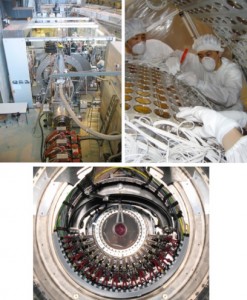Looking beyond the Standard Model through rare muon decay World’s most sensitive search to examine Grand Unified Theory


(Top left) The apparatus of the MEG experiment in theπE5 beam line of the Paul Scherrer Institute,
(top right) the inside of the LXe γ-ray detector when many photo-sensors to detect LXe scintillation light from γ-ray interactions were being assembled, and
(bottom) the positron spectrometer where an oval-shaped thin plastic target to stop the muon beam is surrounded by radially aligned drift chamber modules for a precise measurement of the positron track.
© MEG collaboration
The international research collaboration MEG, in which a team of the University of Tokyo participates as a core institute, has searched for a rare muon decay, μ→eγ, with unprecedented sensitivity utilizing the world’s most intense muon beam at the Paul Scherrer Institute (PSI) in Switzerland and innovative particle detectors specially developed for the experiment.
The decay μ→eγ, which is forbidden in the Standard Model of elementary particles, is predicted to occur at a measurable rate by new physics models beyond the Standard Model such as supersymmetric grand unified theory (SUSY-GUT).
No μ→eγ decay was found in this search, which is a factor of twenty more sensitive than the previous experiment (a factor of four more sensitive than the previous result of this experiment presented in 2011). The absence of the decay provides one of the most stringent constraints on the new physics models together with the recent results from the LHC experiments.
The importance of even more sensitive search is getting higher. The MEG experiment is expected to double the amount of data gathered by summer in 2013. Furthermore, an upgrade of the experiment with major improvements in the detectors was approved by the PSI committee in January 2013. The upgraded experiment is planned to start in 2016 with sensitivity an order of magnitude higher than the current MEG experiment.
Press release (Japanese)
Paper
J. Adam et al. MEG Collaboration,
“New constraint on the existence of the μ+→e+γ decay”,
Physical Review Letters (in press) arXiv:1303.0754 [hep-ex] Online Edition: 2013/3/4,
Article link
Links
International Center for Elementary Particle Physics (ICEPP)






